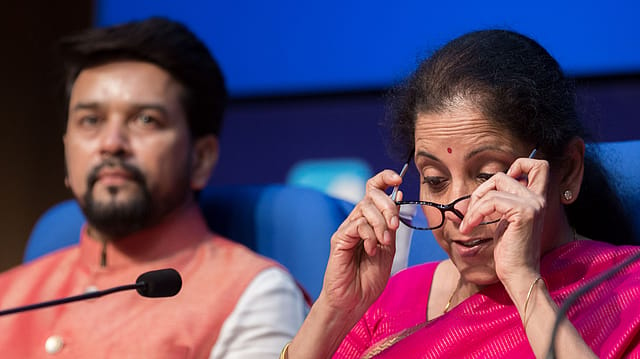Finance minister holds review meeting with bankers
ADVERTISEMENT

Finance minister Nirmala Sitharaman plans to hold a series of meetings to discuss current economic issues with key stakeholders, including those from sectors undergoing a slowdown. In a first such meeting in New Delhi on Monday, the finance minister along with RBI deputy governor N. S. Vishwanathan reviewed the performance of the banking sector with heads of public sector banks (PSBs) and private lenders including HDFC Bank, ICICI Bank, Axis Bank, Kotak Mahindra Bank and Citi Bank.
“This will be followed by meetings with the MSME sector, the automobile sector, industry associations, financial market stakeholders, and real estate and home-buyers in coming days,” a finance ministry statement said. “The government will factor in the takeaways from these consultations for appropriate policy responses to maintain a high growth trajectory and to address sector-specific issues.”
The review meeting with bankers focussed on overall credit growth to support the needs of the economy and ways in which they can help growth-driving sectors in dealing with current issues. “In particular, the credit needs of the NBFC, automobiles and MSME sectors were discussed,” according to the statement. “Transmission of benefits of rate cuts to borrowers and industry was also discussed.”
January 2026
Netflix, which has been in India for a decade, has successfully struck a balance between high-class premium content and pricing that attracts a range of customers. Find out how the U.S. streaming giant evolved in India, plus an exclusive interview with CEO Ted Sarandos. Also read about the Best Investments for 2026, and how rising growth and easing inflation will come in handy for finance minister Nirmala Sitharaman as she prepares Budget 2026.
The statement highlighted that overall credit growth from the banking system continues to be at 12%, marginally lower than the growth of 13.3% at the end of March. At the same time, with a turnaround in the NPA cycle, a high provision cover of over 75%, and record recovery, bank balance-sheets are healthier than before. “Banks are now, therefore, in position to step up lending,” said the ministry.
The banking sector promised to take more steps in order to address the liquidity crunch that NBFCs are facing since IL&FS' default last year. Banks committed to leverage co-origination of loans jointly with NBFCs under the RBI’s co-origination policy. This, according to the ministry, will combine the advantages of lower-cost funds and large financing capacity of banks, with the doorstep reach of the NBFC sector, and benefit both.
For the NBFC sector, it was noted in the review that bank credit to the NBFC and housing finance companies (HFC) sector has risen by nearly ₹90,000 crore since September 2018, helping address the sector’s liquidity needs. In addition, pool buy-outs of over ₹40,000 crore by PSBs have helped the NBFC and HFC sector reduce their asset liability mismatch. Bankers committed to continue supporting the sector by making prudent use of partial credit guarantee from the government for purchase of pooled assets of NBFCs and HFCs of up to ₹1 lakh crore, as proposed by Sitharaman in her maiden budget.
The finance ministry highlighted that the National Housing Bank (NHB) has launched a new scheme to refinance HFCs for their pool of existing developer loans as well as individual housing loans. HFCs can then use the liquidity exclusively for individual loans for affordable housing.
Meanwhile, the automobile sector has witnessed falling sales driven by vehicle loans, in which NBFCs had a major share. “In view of the decline in NBFC credit for vehicle finance, banks have committed to step up credit support for vehicle purchases,” the ministry said.
The ministry added that banks would double efforts to extend cheaper, hassle-free and cash-flow based credit to MSMEs by leveraging GST, digital payments and alternate data. Banks would also expedite restructuring of viable MSME units facing stress, under the special MSME restructuring dispensation available till March 2020. “The recommendations of the U. K. Sinha committee would be taken forward,” the statement said. “The committee had highlighted the need to meet working capital requirements of India’s growing MSME service.” Banks also agreed to bring out specific working capital products for service sector MSME units.
Beyond the distressed sectors, the finance ministry highlighted that as a result of government’s thrust on digitalisation, digital transactions grew to 769% of the GDP by March 2019, up from 726% a year ago. The recent amendments mandating that business establishments with over ₹50 crore turnover accept digital payments and waiver of charges on NEFT and RTGS is expected to give a fillip to further digitalisation. In the review, banks committed to review charges on digital payments with a view to making them cheaper for customers vis-à-vis cash payments. “They also committed to expand services available through mobile and internet banking and offer services on these digital platforms in regional languages as well,” the statement said.
The ministry also highlighted that since December 2018, the monetary policy has been eased substantially with policy rates being cut by 75 basis points and the policy outlook changed to accommodative. “Banks need to commensurately transmit rate cut benefit in lending,” the ministry said. In the meeting, banks agreed to take steps as per RBI guidelines to review their lending rates.
At a time when the macro economy is going through a growth moderation, the step by the finance minister is expected to boost the sentiment across sectors. While there were signs that the finance minister was not keen to review her budget proposals, the series of planned meetings seem to indicate that the government is keen to ease the pain the economy is going through.
